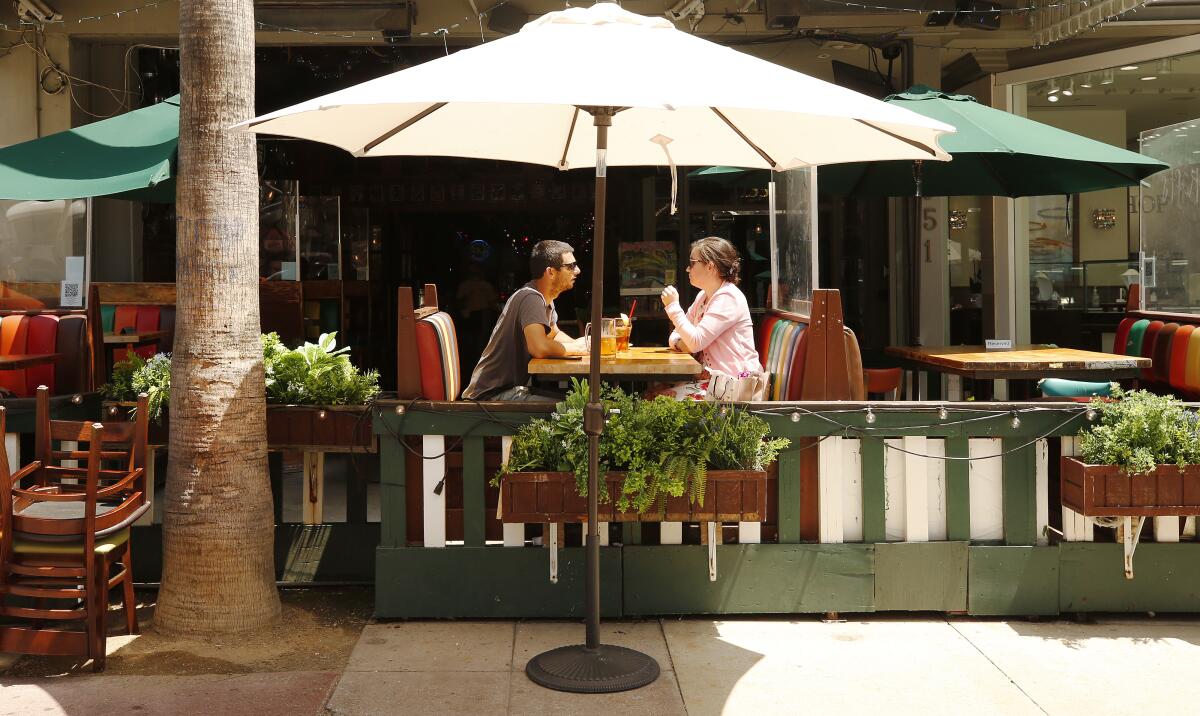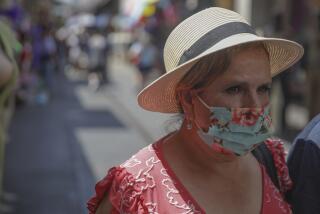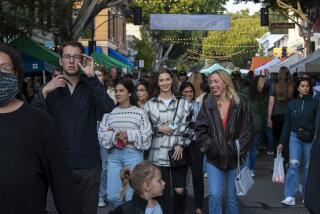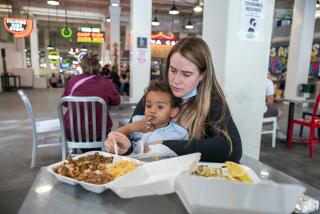What the biggest L.A. County reopening yet allows you to do

- Share via
Los Angeles County and San Francisco have entered California’s most lenient yellow COVID-19 tierthis week, allowing the economy to be reopened to the widest extent currently possible.
It is L.A. County’s first time in the yellow tier, and San Francisco’s second time — after previously making it there last fall before the deadly autumn-and-winter surge swept much of the state.
In general, reaching this level allows capacity to expand at restaurants, gyms, movie theaters, amusement parks, sports venues and museums. Bars can also reopen indoors without needing to serve meals, and saunas and steam rooms can also reopen.
New local health orders permitting wider reopenings took effect in L.A. County on Thursday at 12:01 a.m., and in San Francisco at 8 a.m.
Health officials said the progress vindicates the months-long collective efforts of residents to get vaccinated, mask up and stay socially distanced.
“The hard work we’re doing as a community to protect ourselves and each other from this infection is allowing us to return to the many activities we cherish,” L.A. County Public Health Director Barbara Ferrer told the Board of Supervisors. “Thanks to everyone for all the masking, distancing, hand washing and vaccinating.”
L.A. County is the first in Southern California to reach the state’s yellow tier since the color-coded reopening system was established last summer.
Supervisor Hilda Solis called the greater reopening “exciting” but also urged people who aren’t yet fully vaccinated to be cautious. It takes two weeks after a person’s final vaccine dose for someone to be considered fully vaccinated.
Only 47% of L.A. County residents have received at least one dose of vaccine; health experts have said it would be helpful to get overall vaccination rates above 80% or higher.
“We still have a lot more work to do,” Solis said.
Here’s more information on what’s allowed as of Thursday in Los Angeles County. In some cases, L.A. County’s rules are more specific or stricter than required by the state, and sometimes local officials wait longer than required by the state to relax rules.
New changes
Amusement parks and fairs can expand attendance to 35% of capacity, up from 25% in the orange tier. Visitors must either be a California resident or fully vaccinated.
Restaurants are no longer capped at 200 people, as is required in the orange tier, but must still operate at no more than 50% capacity indoors. The distance between tables can be reduced from eight feet apart to six feet apart.
If everyone in a group is vaccinated, a maximum of six people can now sit at an indoor table from six households; and a maximum of eight people can now sit at an outdoor table from eight households. There are no capacity limits outdoors, other than the requirement to keep tables at least six feet away from each other.
If not everyone is fully vaccinated, an indoor table can still only host people who all live in the same household; an outdoor table can still only host guests from no more than three different households; but outdoor tables can now host up to eight people, a more relaxed threshold than the previous maximum of six people.
Televisions may be turned on in indoor and outdoor dining areas.
Proof of full vaccination can be provided with photo ID and a vaccination card or a photo of the vaccination card on a cellphone.
Movie theaters can expand to up to 50% of capacity — up from the previous cap of 25% or 100 people, whichever is fewer. Capacity is limited to ensure there is at least six feet of distance between groups. But there can be fully vaccinated seating sections established in a theater, and certain restrictions for those areas are relaxed. Eating is allowed but only in designated areas or a reserved seat.
Bars that don’t serve food can reopen indoors, with a maximum capacity of 25% or 100 people, whichever is fewer. Masks must be worn and can be removed only when seated at a table and eating or drinking. Customers cannot sit, nor be served, at the counter.
Customers must be seated to consume any beverages, and must not walk around or stand while eating or drinking.
In indoor seating areas, tables must be at least six feet apart, and can have no more than six people in the same party and they must be members of the same household — unless everyone shows proof of being fully vaccinated, in which case all six people can come from as many as six households.
In outdoor seating areas, tables must still be at least eight feet apart, but can now have no more than eight people instead of no more than six. They must be members of the same household, unless everyone in the party shows proof of full vaccination, in which case they can come from as many as eight households.
Live entertainment is now allowed outdoors, but still banned indoors. Televisions can now be turned on indoors.
Restrictions on operating hours of bars were lifted last week.
Wineries, breweries and distilleries that don’t serve meals can expand to 50% of capacity or 200 people, whichever is fewer. In the orange tier, the limit was 25% or up to 100 people. Live entertainment is not allowed indoors. These establishments are bound by the same rules as bars for their outdoor areas. Restrictions on operating hours were lifted last week.
Gyms and fitness centers can expand indoor capacity to 50%, up from 25%. Indoor showers, locker rooms, pools, saunas and steam rooms can open at 50% capacity; physical distancing between customers must be adhered to while customers are in locker rooms, pools, saunas and steam rooms. Masks are always required, except for swimming.
Cardrooms, racetracks and satellite wagering sites can open up indoors at 50% capacity, up from 25%. Tables must be separated from each other by at least six feet. Masks are required. Food and beverages remain prohibited at the tables.
Saunas and steam rooms can reopen, up to a maximum of 50% capacity, and while practicing physical distancing while in locker rooms, saunas and steam rooms. In the orange tier, saunas and steam rooms were shut.
Water parks can reopen and are allowed to be open at 40% capacity with safety modifications.
Museums, zoos and aquariums can be open indoors at 75% capacity, up from 50% capacity.
Outdoor seated live events, such as baseball games, can expand to 67% of capacity in the yellow tier; state rules limited capacity to 33% in the orange tier. Suites remain capped at 25% capacity, but if everyone is fully vaccinated, the suites can operate at full capacity.
People are considered fully vaccinated if it’s been two or more weeks since receiving their second Pfizer or Moderna vaccine dose, or two or more weeks since receiving their Johnson & Johnson vaccine. Children age 2 or older not eligible to be vaccinated may sit with their parent or sponsor in the fully vaccinated-only section only if they are tested for the coronavirus.
Indoor seated live events and performances in large-capacity venues — with capacity for more than 1,500 guests — can reach 10% of capacity or 2,000 guests, whichever is fewer, but if everyone has a negative test or has proof of full vaccination, the limit can increase to 50%, up from 35% in the orange tier.
In smaller venues of up to 1,500 guests, indoor live venues are capped at 25% of capacity or 300 people in the yellow tier, whichever is fewer, or up to 50% if all guests are tested or can show proof of full vaccination. In the orange tier, state rules required smaller venues to limit capacity to 15% of capacity or 200 people, whichever is fewer, or up to 35% of capacity if all guests are tested or can show proof of vaccination.
In all such indoor venues, only California residents or those who are fully vaccinated are permitted; drinking and eating are allowed only in designated areas in situations where everyone either has tested negative or has proof of full vaccination; suites can hold no more than 25% of capacity, with a maximum of members of three households in attendance; however, if everyone in a suite is vaccinated, suites may be occupied at full capacity.
Informal social gatherings are now allowed to be expanded to 100 people outdoors; and, while indoor gatherings continue to be strongly discouraged, allowed at up to 50% of a venue’s capacity or up to 50 people, whichever is fewer. In the orange tier, outdoor attendance was limited to 50 people; with indoor events capped at up to 25% of capacity or 25 people, whichever was fewer.
Community sporting events are limited to no more than 1,500 participants, with no more than 500 participants per hour. If everyone has tested negative or are fully vaccinated, the events can host up to 3,000 participants.
Offices can hold up to 75% of maximum occupancy, unless all staff are vaccinated. Physical distancing and masking requirements remain in effect.
What hasn’t changed
Indoor family entertainment centers, such as arcades, indoor playgrounds, bounce centers, ball pits and laser tag arenas, were allowed just last week to open to 25% of capacity.
Conferences, receptions and meetings are still regulated by standards in the orange tier, in which attendance is limited to a maximum of 100 people outdoors, or up to 300 people outdoors if everyone tests negative or shows proof of full vaccination. Indoor events are allowed for up to 150 people, only if all guests are tested or show proof of full vaccination.
The county could later choose to align with what’s permitted by the state in the yellow tier. The state allows counties in the yellow tier to permit conferences, receptions and meetings to accommodate up to 200 people outdoors, or up to 400 people outdoors if everyone tests negative or shows proof of full vaccination. Indoor events can be held only if all guests show proof of negative test or show proof of full vaccination, and are limited to a maximum of 200 people.
Conferences, meetings and receptions need to have assigned seating, and there is to be no intermingling of private events.
Grocery and retail stores and malls remain limited to 75% of capacity, with distancing of at least six feet between customers.
Hair salons, barbershops and other personal care services remain limited to 75% of capacity; masks are required except for services where customers need to remove their masks, in which case staff must wear a fitted N95 mask or a face covering with a face shield.
Churches are recommended to keep attendance at limited capacity. They are required to follow physical distancing rules.
California is aiming to scrap the tier framework and fully reopen its economy June 15, as long as the supply of COVID-19 vaccine is stable and hospitalization numbers stay low.
But some safety rules will remain in place. For instance, large-scale indoor events, such as conventions, are expected to be allowed to resume, but with testing or vaccination verification requirements, the governor’s office has said.
More to Read
Sign up for Essential California
The most important California stories and recommendations in your inbox every morning.
You may occasionally receive promotional content from the Los Angeles Times.












